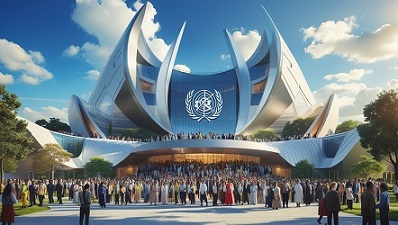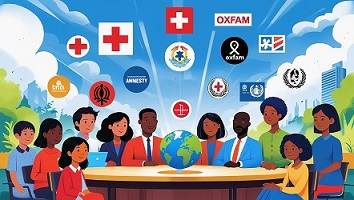Ever wonder which organization has a bigger global workforce than tech giants like Apple and Google combined? BRAC, based in Bangladesh, operates in 11 countries with over 100,000 employees – making it the largest non governmental organization in the world that most people have never heard of.
Think about that for a second. An NGO that reaches 138 million people yet flies under the radar of common knowledge.
BRAC isn’t just big – it’s effective. While other organizations spend years debating approaches, BRAC pioneered microfinance and has lifted millions from poverty through its practical, scalable programs.
But what makes an organization grow from a small relief operation to a global force? And why does BRAC’s model work when so many other well-funded initiatives fail?
Read more: Group purchasing organizations list GPOs

Understanding the Landscape of Global NGOs
Defining What Makes an NGO “Large”
Ever wondered what separates the big players from small local charities in the NGO world? Size isn’t just a simple headcount or office space measurement.
When we talk about “large” NGOs, we’re looking at a mix of factors. Budget size often tops the list – largest non governmental organization handling billions rather than millions tend to make the cut. But it’s also about geographical reach. Does the NGO operate in 5 countries or 50? The truly massive ones have boots on the ground across multiple continents.
Impact scope matters too. Some NGOs focus deeply on one issue in one region, while the giants tackle multiple causes worldwide – from healthcare to education to disaster relief, often simultaneously.
Metrics Used to Measure NGO Size
The NGO world doesn’t have a single yardstick for size, but these metrics usually tell the story:
- Annual budget/revenue: The clearest indicator, ranging from millions to billions
- Staff size: Both paid employees and volunteer networks
- Geographical footprint: Number of countries with active operations
- Beneficiary reach: How many people directly benefit from programs
- Program diversity: Number of different initiatives and focus areas
Take BRAC, for example. With over 100,000 employees, it dwarfs many multinational corporations in workforce size alone.
Top Contenders for the Title
The race for “largest non governmental organization” has several heavyweight contenders:
| Organization | Founded | Annual Budget | Countries | Key Focus Areas |
|---|---|---|---|---|
| BRAC | 1972 | $1.1+ billion | 11 | Poverty, education, healthcare |
| Oxfam International | 1942 | $1.3+ billion | 90+ | Poverty, disaster relief |
| CARE International | 1945 | $800+ million | 100+ | Emergency response, poverty |
| Save the Children | 1919 | $2+ billion | 120+ | Children’s rights, education |
| Médecins Sans Frontières | 1971 | $1.9+ billion | 70+ | Medical humanitarian aid |
BRAC often claims the crown based on staff size, while others point to Save the Children’s broader geographical reach.
Historical Growth of Major NGOs
The evolution of today’s mega-NGOs is fascinating. Most started small, focused on specific crises.
Take Oxfam – born to fight famine in Greece during WWII, it transformed into a global poverty-fighting machine. Similarly, Save the Children began helping starving German children after WWI before expanding worldwide.
The real growth explosion happened in the 1970s-90s when international development funding surged. Organizations that once operated in handful of countries suddenly expanded to dozens.
Technology played a huge role too. The internet revolutionized fundraising and coordination, allowing NGOs to scale operations beyond what was previously possible.
BRAC: The World’s Largest NGO
Origins and Foundation Story
Ever heard of an NGO so big it basically changes the game for millions of people? That’s BRAC for you.
BRAC began in 1972 when Fazle Hasan Abed, a Bangladeshi executive, witnessed the devastation of his country following both the Bangladesh Liberation War and a deadly cyclone. Instead of just shaking his head at the tragedy, Abed quit his corporate job and sold his London apartment to fund relief efforts in rural Bangladesh.
He started small—really small—focusing on helping refugees in a remote area called Sulla. What began as a temporary relief operation quickly evolved when Abed realized something crucial: short-term aid wasn’t going to cut it.
“I thought we would be involved in relief work for a few months, the refugees would go back home, and we would all go back to our lives,” Abed once said. But reality had other plans.
By 1973, BRAC shifted focus to long-term development, tackling poverty at its roots. The name initially stood for “Bangladesh Rehabilitation Assistance Committee,” later changing to “Bangladesh Rural Advancement Committee” before simply becoming BRAC as its work expanded globally.
Key Areas of Operation
BRAC doesn’t just dip its toes in the water—it jumps in headfirst. Their approach? Hit poverty from every angle possible.
The organization operates across several crucial sectors:
- Microfinance: They pioneered models that deliver financial services to those traditionally excluded from banking systems.
- Education: BRAC runs one of the world’s largest private, secular education systems, with particular focus on girls’ education.
- Healthcare: From maternal health to infectious disease control, BRAC deploys community health workers to reach the most isolated communities.
- Agriculture & Food Security: Supporting small-scale farmers with training, resources, and market access.
- Social Enterprises: Running businesses that both generate income and address social needs.
What makes their approach unique is how these programs interlock. A family might receive a microloan, send kids to a BRAC school, and get healthcare from a BRAC clinic—all while learning better farming techniques from BRAC agriculture specialists.
Global Reach and Impact
BRAC’s footprint is massive—no exaggeration.
Starting in Bangladesh, they’ve expanded to 11 countries across Asia and Africa, including Afghanistan, Myanmar, Nepal, Philippines, Uganda, Tanzania, Sierra Leone, Liberia, and South Sudan.
The numbers are staggering:
- More than 100 million people reached
- Over 2 million children educated through 40,000+ BRAC schools
- Approximately 5 million microfinance clients (mostly women)
- 100,000+ health volunteers trained
In Bangladesh alone, BRAC has helped contribute to the country’s impressive development indicators, including reduced child mortality, increased school enrollment, and improved women’s economic participation.
Sir Fazle Hasan Abed (who received knighthood from Queen Elizabeth II in 2010) built an organization that’s actually moved the needle on poverty at scale—something many development experts thought impossible.
Financial Structure and Funding Sources
How does an NGO this size keep the lights on? BRAC’s funding model is as innovative as its programs.
Unlike most NGOs that rely heavily on donor funding, BRAC generates a significant portion of its own income through its social enterprises. These include:
- BRAC Bank
- BRAC Dairy
- BRAC Seed Enterprise
- Aarong (retail chain for handicrafts)
These businesses serve dual purposes: generating revenue while addressing social needs. For example, Aarong provides market access for rural artisans while generating profits that fund other BRAC programs.
The funding breakdown looks something like this:
| Source | Approximate % |
|---|---|
| Self-generated (social enterprises) | 70-75% |
| Donor grants | 20-25% |
| Other sources | 5% |
Major donors include the Bill & Melinda Gates Foundation, DFID (UK), USAID, and the World Bank. This diversified funding approach gives BRAC remarkable sustainability and independence.
Organizational Model
BRAC’s organizational structure might be its secret sauce.
Despite its enormous size (employing over 100,000 people), BRAC maintains effectiveness through a decentralized approach. Programs are designed centrally but implemented locally, with significant decision-making authority pushed down to field offices.
The organization follows a few core principles:
- Community-based approach: Programs are implemented by local staff who understand cultural contexts
- Cost-effectiveness: Solutions must be affordable and scalable
- Data-driven decision making: Rigorous monitoring and evaluation
- Adaptive learning: Programs constantly evolve based on evidence
This model allows BRAC to scale rapidly while staying relevant to local needs. When something works in one region, it’s tested, adapted, and rolled out elsewhere.
BRAC University, established in 2001, further supports this model by training development professionals and conducting research that informs BRAC’s programs.
Read more: Top Group Purchasing Organizations

Success Factors Behind the Largest NGOs
Effective governance structures
The backbone of mega-NGOs isn’t fancy websites or celebrity endorsements – it’s solid governance. Organizations like BRAC and Médecins Sans Frontières have mastered the art of balancing centralized decision-making with field autonomy. They’ve created board structures that blend diverse expertise while maintaining laser-focus on their mission.
What makes these giants different? They’ve implemented robust accountability systems that track impact, not just dollars spent. Their leadership teams typically include both development experts and business minds who speak each other’s language.
Innovative funding approaches
Gone are the days when NGOs survived on donations alone. The largest organizations have revolutionized their funding models through:
- Social enterprises that generate sustainable income
- Impact investing partnerships
- Innovative microfinance programs
- Membership models that provide predictable revenue streams
Take Grameen Bank – they transformed from a traditional charity into a self-sustaining financial institution. Or look at Oxfam’s fair trade shops that both fund programs and advance their mission.
Partnerships with governments and private sector
The real secret sauce? Strategic partnerships. Major NGOs don’t go it alone.
CARE International has mastered the art of working alongside governments without losing independence. They provide technical expertise while governments contribute infrastructure and policy support. Meanwhile, Save the Children has forged corporate partnerships that go beyond corporate social responsibility checkboxes.
These relationships work because they’re mutually beneficial. Governments gain implementation expertise, companies access on-the-ground networks, and NGOs gain resources and scale.
Technology integration and innovation
Leading NGOs aren’t just adopting technology – they’re pioneering it. From blockchain for transparent aid delivery to AI-powered crop prediction for farmers, they’re pushing boundaries.
Some standout examples:
- Mercy Corps’ digital cash transfers in crisis zones
- IRC’s machine learning systems for predicting refugee movements
- PATH’s mobile health platforms connecting remote communities to medical expertise
The tech isn’t just for show – it’s solving real problems at scale while reducing operational costs.
Community-based approaches
Despite their massive size, the most successful NGOs haven’t lost touch with grassroots principles. They’ve systematized community engagement through:
- Local leadership development programs
- Community-owned decision-making frameworks
- Indigenous knowledge integration
World Vision’s Area Development Programs exemplify this approach, building long-term relationships in communities rather than swooping in with predetermined solutions. This creates sustainability long after the NGO exits.
The magic happens when communities themselves become the architects and owners of development initiatives. This isn’t just feel-good rhetoric – it delivers measurable improvements in program effectiveness and longevity.
Challenges Facing Large-Scale NGOs
Maintaining accountability and transparency
Running the world’s largest NGOs isn’t exactly a walk in the park. When you’re handling millions in donations and working across dozens of countries, people want answers. Donors demand to know where their money goes. Beneficiaries need assurance they’re getting fair treatment. And governments? They’re watching your every move.
The bigger an organization grows, the harder transparency becomes. BRAC, with operations in 11 countries and over 100,000 employees, must maintain detailed records of every dollar spent. That’s a mountain of paperwork and digital systems to manage.
The trust factor is everything. One financial scandal can undo decades of goodwill. Just ask Oxfam, whose reputation took a massive hit after misconduct allegations in Haiti. Recovery isn’t quick or easy.
Balancing growth with mission integrity
Growth is tempting. More funding means helping more people, right? Not so fast.
Many massive NGOs struggle with “mission drift” – gradually shifting away from their original purpose as they expand. When you’re chasing grants and donations, it’s easy to start tailoring your work to please funders rather than serve communities.
Consider the dilemma: turn down millions in funding that doesn’t perfectly align with your mission, or compromise a bit to help more people? There’s no perfect answer.
The organizations that navigate this best maintain strong leadership with clear vision. They’re willing to say “no” to opportunities that pull them off course, even when the money’s good.
Navigating political complexities across borders
Global NGOs essentially run mini-diplomatic missions. They’re constantly balancing relationships with:
- Host governments who may be suspicious of foreign organizations
- Donor governments with their own political agendas
- Local power structures that can help or hinder work
- International bodies like the UN
The Doctors Without Borders team in Afghanistan knows this reality all too well. When political tides shift, their entire operation can be threatened overnight.
Political neutrality sounds good in theory but proves incredibly difficult in practice. How do you remain neutral when working in conflict zones? When do you speak out against injustice, and when do you stay quiet to maintain access to vulnerable populations?
Adapting to changing funding landscapes
The funding game has changed dramatically. Traditional donors like governments and large foundations now demand more metrics, more innovation, and more partnerships.
Individual giving patterns have shifted too. Today’s donors want:
- Direct impact they can see
- Regular updates on their specific contributions
- Lower administrative costs
- Technology-enabled giving options
Meanwhile, corporate partnerships bring both opportunities and risks. Take those corporate millions and you might face accusations of “greenwashing” or ethical compromises.
Smart NGOs are diversifying income streams through social enterprises, membership models, and creative partnerships. The days of relying solely on grants and donations are over.
Conclusion
The global landscape of non-governmental organizations reveals remarkable institutions that have grown to unprecedented scales, with BRAC standing out as the world’s largest NGO. This Bangladesh-based organization has transformed from a small relief operation into a multinational force for development, reaching millions across Asia, Africa, and beyond. While other significant players like Oxfam, Save the Children, and Médecins Sans Frontières continue to make tremendous impacts worldwide, BRAC’s innovative approaches to poverty reduction and community empowerment have set new standards for the sector.
Behind these massive organizations lies a common thread of success factors: strategic scaling of proven interventions, diverse funding models, and strong local partnerships. However, their size also brings unique challenges, from maintaining accountability across vast operations to balancing standardization with local needs. As these organizations navigate the complexities of global development work, their continued evolution and adaptation will remain crucial to addressing the world’s most pressing humanitarian and social challenges.



